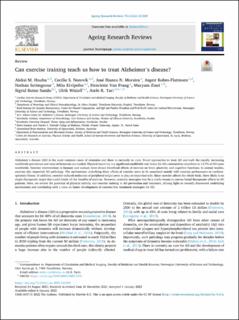| dc.contributor.author | Huuha, Aleksi Matias | |
| dc.contributor.author | Norevik, Cecilie Skarstad | |
| dc.contributor.author | Moreira, Jose Bianco Nascimento | |
| dc.contributor.author | Kobro-Flatmoen, Asgeir | |
| dc.contributor.author | Scrimgeour, Nathan Robert | |
| dc.contributor.author | Kivipelto, Miia | |
| dc.contributor.author | Van Praag, Henriette | |
| dc.contributor.author | Ziaei, Maryam | |
| dc.contributor.author | Sando, Sigrid Botne | |
| dc.contributor.author | Wisløff, Ulrik | |
| dc.contributor.author | Tari, Atefe R | |
| dc.date.accessioned | 2023-04-14T13:42:39Z | |
| dc.date.available | 2023-04-14T13:42:39Z | |
| dc.date.created | 2022-04-22T13:24:25Z | |
| dc.date.issued | 2022 | |
| dc.identifier.citation | Ageing Research Reviews. 2022, 75 . | en_US |
| dc.identifier.issn | 1568-1637 | |
| dc.identifier.uri | https://hdl.handle.net/11250/3063185 | |
| dc.description.abstract | Alzheimer’s disease (AD) is the most common cause of dementia and there is currently no cure. Novel approaches to treat AD and curb the rapidly increasing worldwide prevalence and costs of dementia are needed. Physical inactivity is a significant modifiable risk factor for AD, estimated to contribute to 12.7% of AD cases worldwide. Exercise interventions in humans and animals have shown beneficial effects of exercise on brain plasticity and cognitive functions. In animal studies, exercise also improved AD pathology. The mechanisms underlying these effects of exercise seem to be associated mainly with exercise performance or cardiorespiratory fitness. In addition, exercise-induced molecules of peripheral origin seem to play an important role. Since exercise affects the whole body, there likely is no single therapeutic target that could mimic all the benefits of exercise. However, systemic strategies may be a viable means to convey broad therapeutic effects in AD patients. Here, we review the potential of physical activity and exercise training in AD prevention and treatment, shining light on recently discovered underlying mechanisms and concluding with a view on future development of exercise-free treatment strategies for AD. | en_US |
| dc.language.iso | eng | en_US |
| dc.publisher | Elsevier | en_US |
| dc.rights | Navngivelse 4.0 Internasjonal | * |
| dc.rights.uri | http://creativecommons.org/licenses/by/4.0/deed.no | * |
| dc.title | Can exercise training teach us how to treat Alzheimer's disease? | en_US |
| dc.title.alternative | Can exercise training teach us how to treat Alzheimer's disease? | en_US |
| dc.type | Peer reviewed | en_US |
| dc.type | Journal article | en_US |
| dc.description.version | publishedVersion | en_US |
| dc.source.pagenumber | 0 | en_US |
| dc.source.volume | 75 | en_US |
| dc.source.journal | Ageing Research Reviews | en_US |
| dc.identifier.doi | 10.1016/j.arr.2022.101559 | |
| dc.relation.project | Norges forskningsråd: 223262 | en_US |
| dc.relation.project | Norges teknisk-naturvitenskapelige universitet: xxxxxx | en_US |
| cristin.ispublished | true | |
| cristin.fulltext | original | |
| cristin.qualitycode | 1 | |

